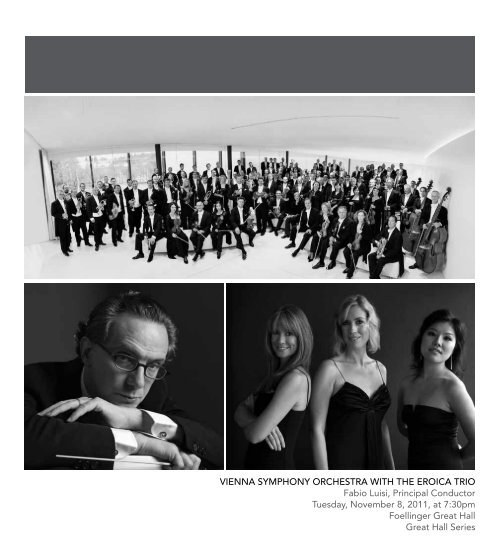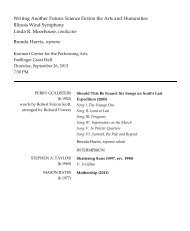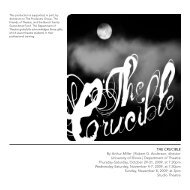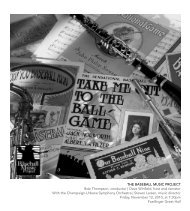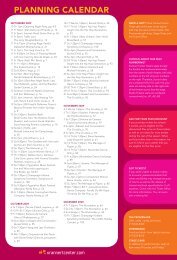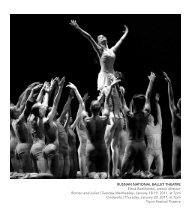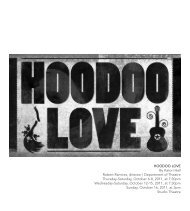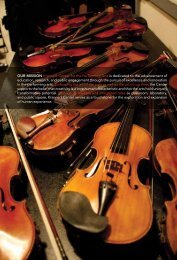VIENNA SYMPHONY ORCHESTRA WITH THE EROICA TRIO Fabio ...
VIENNA SYMPHONY ORCHESTRA WITH THE EROICA TRIO Fabio ...
VIENNA SYMPHONY ORCHESTRA WITH THE EROICA TRIO Fabio ...
You also want an ePaper? Increase the reach of your titles
YUMPU automatically turns print PDFs into web optimized ePapers that Google loves.
Vienna Symphony orcheStra with the eroica trio<br />
<strong>Fabio</strong> Luisi, Principal Conductor<br />
Tuesday, November 8, 2011, at 7:30pm<br />
Foellinger Great Hall<br />
Great Hall Series
Yes. Life-affirming experience. The heart and soul of<br />
Krannert Center.<br />
A place for those who seek meaning through<br />
moment after moment after moment of shared<br />
life-affirming experiences that stretch across time<br />
and memory through the art of sound. The art of<br />
human movement. Of the spoken word. And every<br />
combination thereof and beyond.<br />
That is to say, a place for the art of the imagination<br />
writ large.<br />
A place to celebrate our individual and collective<br />
ability to rethink the past and present and to<br />
imagine the possibilities of a world neither defined<br />
nor limited by the seemingly endless obstacles of<br />
our time.<br />
A world that more fully and courageously embraces<br />
beauty. Joy. Ambiguity. The impulse to inquire. To<br />
reflect. And to lift up one another.<br />
Welcome to this season of shared moments and<br />
the deep privilege of being together. Welcome to<br />
Krannert Center.<br />
All good things,<br />
Mike Ross<br />
Director<br />
yes *<br />
[A MeSSAGe FROM THe DiReCTOR]<br />
* [ life-affirming experience ]<br />
the act of giving<br />
We honor the memory of endowed Sponsor<br />
Doloris Dwyer, whose legacy gift continues to<br />
bring moments of power and inspiration to this<br />
entire community. Because of her foresight, we<br />
can enjoy the enduring beauty of classical music<br />
for years to come.<br />
endowed Sponsors Lois & Louis Kent have<br />
demonstrated a fierce commitment to the<br />
arts through their legacy gift. We at Krannert<br />
Center are grateful for their generosity and their<br />
willingness to share their abiding love of the<br />
arts with us all.<br />
2<br />
3
Krannert Center honors the unwavering dedication of these supporters. They have ensured that the<br />
2011-2012 season is filled with moment after moment of deeply felt experience.<br />
the act of giving<br />
HeLeN & DANieL RiCHARDS*<br />
TWeNTY-TWO PReViOuS SPONSORSHiPS<br />
MARGAReT & LARRY NeAL*<br />
NiNe PReViOuS SPONSORSHiPS<br />
ANONYMOuS<br />
FORTY-TWO PReViOuS SPONSORSHiPS<br />
Six CuRReNT SPONSORSHiPS<br />
CAROLYN BuRReLL*<br />
TeN PReViOuS SPONSORSHiPS<br />
SeLMA RiCHARDSON*<br />
eiGHT PReViOuS SPONSORSHiPS<br />
TWO CuRReNT SPONSORSHiPS<br />
CORPORATe BRONze SPONSOR<br />
FiRST SPONSORSHiP<br />
Dixie & eVAN DiCKeNS*<br />
TWeNTY-THRee PReViOuS SPONSORSHiPS<br />
FOuR CuRReNT SPONSORSHiPS<br />
PNiNA & GADi STeiNeR<br />
FiVe PReViOuS SPONSORSHiPS<br />
Vienna Symphony Orchestra<br />
<strong>Fabio</strong> Luisi, Principal Conductor<br />
eroica Trio<br />
erika Nickrenz, Piano<br />
Susie Park, Violin<br />
Sara Sant’Ambrogio, Cello<br />
program<br />
Ludwig van Beethoven Concerto for Violin, Cello, and Piano in C Major, Op. 56, “Triple Concerto”<br />
(1770-1827) Allegro<br />
eroica Trio, Soloists Largo (attacca)<br />
Rondo alla polacca<br />
20-minute intermission<br />
Johannes Brahms Symphony No. 2 in D Major, Op. 73<br />
(1833-1897) Allegro non troppo<br />
Adagio non troppo<br />
Allegretto grazioso, quasi andantino<br />
Allegro con spirito<br />
This program is subject to change.<br />
Tour Direction:<br />
Columbia Artists Management LLC<br />
Tim Fox/Alison Ahart Williams<br />
1790 Broadway<br />
New York, NY 10019<br />
www.cami.com<br />
4 * PHOTO CReDiT iLLiNi STuDiO<br />
5
vienna SYmphonY orcheStra<br />
DoubLe baSS<br />
Markus Obmann, Third Horn<br />
ivan Kitanovič, Principal<br />
elmar eisner, Fourth Horn<br />
ernst Weissensteiner, Principal<br />
Alois Schlor, Fourth Horn<br />
<strong>Fabio</strong> Luisi, Principal Conductor<br />
firSt vioLin<br />
Jan Pospichal, First Concertmaster<br />
Anton Sorokow, First Concertmaster<br />
Florian zwiauer, First Concertmaster<br />
Guillermo Büchler, Third Concertmaster<br />
Alexander Burggasser, Fourth Concertmaster<br />
Stephan Achenbach<br />
Christian Birnbaum<br />
Maximilian Dobrovich<br />
Claire Dolby<br />
Roxana Dura<br />
Franz Michael Fischer<br />
Nicolas Geremus<br />
Peter-Michael Grosch<br />
Helmut Lackinger<br />
Mariam Margaryan-Petkova<br />
Wolfgang Schuchbaur<br />
Maiko Seyama<br />
Agata Sikorska<br />
Wolfgang Trauner<br />
Renate Turon<br />
Gerald Wilfinger<br />
vioLa<br />
Johannes Flieder, Principal<br />
Herbert Müller, Principal<br />
Roman Bernhart, Assistant Principal<br />
Vera Reigersberg, Assistant Principal<br />
Michael Buchmann<br />
Werner Frank<br />
Herman eisterer, Assistant Principal<br />
Werner Fleischmann<br />
ivaylo iordanov<br />
Martin Kabas<br />
Dragan Lončina<br />
Christian Roschek<br />
Andreas Sohm<br />
Helmut Stockhammer<br />
Hans Joachim Tinnefeld<br />
fLute<br />
Karl-Heinz Schütz, Principal<br />
Robert Wolf, Principal<br />
Alexandra uhlig, Assistant Principal<br />
Rudolf Huber<br />
Raphael Leone<br />
trumpet<br />
Andreas Gruber, Principal<br />
Rainer Küblböck, Principal<br />
Heinrich Bruckner, Assistant Principal<br />
Christian Löw, Assistant Principal<br />
Karl Steininger<br />
trombone<br />
Otmar Gaiswinkler, Principal<br />
Walter Voglmayr, Principal<br />
Johann Jeitler, Assistant Principal<br />
Reinhard Hofbauer<br />
Wolfgang Pfistermüller<br />
tuba<br />
Franz Winkler<br />
Karl Höffinger<br />
eva-Maria Kabas<br />
Christian Kallinger<br />
Dorice Köstenberger<br />
Martin Lehnfeld<br />
Caroline Löffler<br />
Walter Pflüger<br />
edwin Prochart<br />
eva-Maria Reisinger<br />
Ge Song<br />
Birgit zalodek<br />
SeconD vioLin<br />
Thorwald Almassy, Principal<br />
Dominika Falger, Principal<br />
Libor Meisl, Assistant Principal<br />
elzbieta Szymanska-Čonka, Assistant Principal<br />
ioanna Apostolakos<br />
Christian Blasl<br />
Oliver Breuer<br />
Matthias Honeck<br />
Timon Hornig<br />
Christian Knaus<br />
elena Kodin<br />
Gerhard Kanzian<br />
Christian Kaufmann<br />
Karl-Heinz Krumpöck<br />
Christian Ladurner<br />
Franz Moschner<br />
Martin Ortner<br />
Wolfgang Prochaska<br />
Roland Roniger<br />
ulrich Schönauer<br />
isabella Stepanek<br />
ceLLo<br />
Christoph Stradner, Principal<br />
Attila Székely, Assistant Principal<br />
Kentaro Yoshii, Assistant Principal<br />
Wolfgang Aichinger<br />
György Bognár<br />
Michael Günther<br />
Andreas Pokorny<br />
Christian Schulz<br />
Peter Siakala<br />
Alexandra Ströcker<br />
Günter Thomasberger<br />
Michael Vogt<br />
Romed Wieser<br />
oboe<br />
Paul Kaiser, Principal<br />
Thomas Machtinger, Principal<br />
Peter Schreiber, Assistant Principal<br />
ernst Kobau<br />
cLarinet<br />
Gerald Pachinger, Principal<br />
Alexander Neubauer, Assistant Principal<br />
Manuel Gangl<br />
Siegfried Küblböck<br />
baSSoon<br />
Richard Galler, Principal<br />
Patrick de Ritis, Principal<br />
Robert Gillinger, Assistant Principal<br />
Wolfgang Kuttner<br />
Peter Spitzl<br />
horn<br />
eric Kushner, Principal<br />
Hector McDonald, Principal<br />
Georg Sonnleitner, Second Horn<br />
Gergely Sugár, Second Horn<br />
Josef eder, Third Horn<br />
harp<br />
Volker Kempf<br />
percuSSion<br />
Thomas Schindl<br />
Martin Kerschbaum<br />
Friedrich Philipp-Pesendorfer<br />
timpani<br />
Dieter Seiler<br />
Michael Vladar<br />
management<br />
Johannes Neubert, Managing Director<br />
Beatrice Swoboda, Assistant to Managing Director<br />
Tilman Dost, Director of Artistic Administration<br />
Verena Hager, Artistic Administration<br />
Bettina Büttner-Krammer, Music education<br />
Kurt Danner, Marketing and PR<br />
Corinne Pixner, Director of Orchestra Administration<br />
igor Chomca, Orchestra Administration<br />
Bernhard Kircher, Stage Manager<br />
Herbert engel, Stage Manager<br />
Kurt istler, Stage Manager<br />
Wolfgang Buresch, Librarian<br />
6 7
Franz Breitschopf, Finance and Controlling<br />
Rudolf Streicher, President of the Board<br />
Thomas Angermair, Board<br />
erich Becker, Board<br />
Angelika Möser, Board<br />
Herbert Müller, Chairperson of Work Council<br />
Maximilian Dobrovich, Deputy Chairperson<br />
of Work Council<br />
Thomas Schindl, Work Council<br />
Peter Schreiber, Work Council<br />
elzbieta Szymanska-Čonka, Work Council<br />
Werner Fleischmann, Chairperson<br />
of Development Association<br />
Gergely Sugár, Managing Director, Symphonia<br />
Florian Schulze, Office Manager, Symphonia<br />
Ludwig van Beethoven<br />
Born December 16, 1770, in Bonn, Germany<br />
Died March 26, 1827, in Vienna, Austria<br />
Concerto for Violin, Cello, and Piano in C Major, Op.<br />
56, “Triple Concerto”<br />
The object of much undeserved rebuke, intolerance,<br />
and misunderstanding, no other work by<br />
Beethoven—except perhaps the “Choral Fantasy”—<br />
has been so controversial regarding its merits as the<br />
Triple Concerto. After its premiere performance,<br />
the Allgemeine Musikalische Zeitung reported, “We<br />
also heard a new Concertino by Beethoven which,<br />
however, was not altogether well received”; indeed,<br />
the work was never performed again during the<br />
composer’s lifetime. Some pedantic critics have<br />
commented on its “dryness” of style and have<br />
expounded that its “technical effort outweighs<br />
inspiration” and that it is a “weaker work,” which<br />
“rouses expectations of great music it never fulfills.”<br />
Fortunately today’s experts no longer share these<br />
opinions about Beethoven’s Concerto for Violin,<br />
Cello, and Piano, Op. 56. For instance, the eminent<br />
musicologist Sir Donald Francis Tovey insists that “if<br />
it were not by Beethoven, but by some mysterious<br />
composer who had the romantic good fortune to die<br />
before it came to performance, the very people who<br />
blame Beethoven for writing below his full powers<br />
would be the first to acclaim it as a work of a still<br />
greater composer.” And Tovey further emphasizes:<br />
“Without the Triple Concerto Beethoven could not<br />
have written the Piano Concertos in G and e-flat<br />
[Nos. 4 and 5], nor the Violin Concerto.”<br />
Beethoven’s Triple Concerto has been unjustly<br />
overshadowed by the composer’s better-known<br />
concertos. The tendency has been to wrongly<br />
regard it as a backward-looking homage to the<br />
Baroque concerto grosso, when in fact it is a highly<br />
original work that takes the lead from the sinfonie<br />
concertanti as established by Stamitz, Dittersdorf,<br />
and Johann Christian Bach and is propelled from<br />
where Haydn and Mozart left off. Labeled a “Grand<br />
program noteS<br />
Concerto Concertant” in its first printed edition of<br />
1807, this work was written by Beethoven in 1803-<br />
1804 for his young pupil, the Archduke Rudolph.<br />
it was the archduke who performed the piano part<br />
at the work’s premiere in Vienna’s Augarten in May<br />
1808; the other two soloists were violinist Anton<br />
Seidler and cellist Nikolaus Kraft, the latter for whom<br />
Haydn had written his cello concertos. Dedicated<br />
to “his Majesty” Prince Lobkowitz, the composer’s<br />
patron, the Triple Concerto comes from the same<br />
period as the “eroica” Symphony, the first version<br />
of Fidelio, and the “Waldstein” and “Appassionata”<br />
piano sonatas.<br />
Built upon a vast sonata form, the Allegro first<br />
movement begins quietly with the double basses<br />
intoning the main theme in a mood of some mystery<br />
before the whole orchestra assertively takes it up.<br />
The violins then present the secondary theme in the<br />
dominant key. After a third subsidiary theme that<br />
serves as a bridge, the soloists in the “concertino”<br />
group—the cello, joined by the violin, and followed<br />
by the piano—make their entrance, each one with<br />
its own statements of the main theme. With great<br />
contrapuntal skill, and often with the reduced<br />
texture of chamber music, the themes are then<br />
elaborated and brilliantly varied by the three soloists<br />
and orchestra alike in the harmonically daring<br />
development section. After a pianissimo climax that<br />
gives way to a beautiful cantabile passage for the<br />
soloists, the orchestra charges forth with great élan<br />
to bring the first movement to a brilliant close.<br />
With a dark and solemn mood that foreshadows<br />
the slow movement of the Fifth Piano Concerto,<br />
a short Largo in 3/8 time makes up the middle<br />
movement. it begins with a long-breathed, cantabile<br />
melody in the solo cello supported by a quiet<br />
string accompaniment; this expressive theme is<br />
8 9
then assumed by the woodwinds as the piano plays<br />
accompanimental figurations before the solo violin<br />
claims its share. A somber and mysterious passage<br />
leads directly into the finale without a pause, a<br />
procedure that Beethoven would employ again in his<br />
next two piano concertos.<br />
Although the polonaise was not uncommon as a<br />
finale at the time, the present Rondo alla polacca<br />
provides one of only three examples of this form<br />
in Beethoven’s works. The cello calmly introduces<br />
the recurring main theme that is taken up in turn<br />
by the other two soloists. As the orchestra comes<br />
in, the proceedings gather the momentum that<br />
propels the rest of the movement. Between the<br />
varied restatements of the main theme, the trio of<br />
soloists shine with brilliant chamber-like clarity in the<br />
secondary episodes. After the brisk, penultimate<br />
statement of the theme in double time, the solo<br />
trio plays its written-out cadenza against occasional<br />
chords from the orchestra. As the final pianissimo<br />
trill of the cadenza swells and fades away, the<br />
polonaise theme returns in its original tempo to<br />
bring the concerto to its ceremoniously elegant and<br />
triumphant conclusion.<br />
© 1999 by Columbia Artists Management inc.<br />
Johannes Brahms<br />
Born May 7, 1833, in Hamburg, Germany<br />
Died April 3, 1897, in Vienna, Austria<br />
Symphony No. 2 in D Major, Op. 73<br />
Brahms has often, with arguable justification, been<br />
called the last of the great Classical composers; a<br />
fervent admirer of Beethoven, he was moved by a<br />
desire to be linked to the tradition of the symphony<br />
as set by the master. However, Brahms cannot so<br />
easily be regarded as a mere Neoclassicist (as he<br />
was called in life and even after his death); it is only<br />
the most superficial listener who could deny that<br />
his music possesses qualities of the most intense<br />
Romanticism. The richness and abundance of his<br />
musical genius poured forth in his symphonies, as it<br />
did in his chamber works, choral pieces, and long list<br />
of songs. Like Beethoven before him, he provided<br />
a strong voice, dramatic content, and perfection<br />
of structure to the symphony; this, however, he<br />
complemented with the introduction of the German<br />
lied to the essence of symphonic form. Beethoven<br />
had not made use of this lyric, uncomplicated, and<br />
somewhat rustic vein in his symphonies as it was<br />
later to be found in Brahms’, but the practice was<br />
perpetuated into the turn of the 20th century by<br />
Mahler and to some small degree by Bruckner.<br />
Brahms was over 40 years old when he completed<br />
his First Symphony; having garnered a substantial<br />
reputation with his small-scale works (particularly<br />
his chamber music), and with Schumann’s<br />
pronouncement naming him Beethoven’s successor<br />
as a symphonist, Brahms felt tremendous pressure<br />
and the weight of responsibility in presenting his<br />
first work in the form to the world. As a result,<br />
work on the First Symphony took him 15 years<br />
between initial conception and the production of the<br />
completed score in 1876. Opus 68 turned out to be<br />
a magisterial work, and having overcome his fears<br />
regarding his abilities to compose in the grandest of<br />
forms for instrumental music, he immediately set to<br />
work on his next symphony.<br />
Brahms wrote his Symphony No. 2 in D Major in<br />
1877, completing the score in less than four months.<br />
This work has often been called Brahms’ “Pastoral”<br />
Symphony. There is perhaps an element of truth in<br />
this descriptive nickname, particularly in relation to<br />
the first and second movements and possibly the<br />
third. Of his four symphonies, the tone of the second<br />
is the most idyllic. The serene expression of the<br />
first movement is contrasted with the more deeply<br />
contemplative character of the second movement,<br />
where the lyrical sentiment is most apparent as<br />
the style of the lied is clearly found in the melody.<br />
The third movement demonstrates a skillful use of<br />
variation technique and an effective juxtaposition<br />
of alternating fast and moderately slow sections.<br />
The finale expresses great jubilation. All in all,<br />
Opus 73 provides a vivid example of Brahms’ long<br />
melodic lines, his contrapuntal skill as demonstrated<br />
in the combination of melodic lines, the richness<br />
of harmony dictated by seriousness of purpose,<br />
the impressive coherence obtained in the use of<br />
thematic material, and the feeling of balance and<br />
unity in the structure as a whole.<br />
The first movement, Allegro non troppo, is written in<br />
sonata-allegro form. The tranquil opening of basses,<br />
horns, and woodwinds reveals the emotional tone<br />
as well as the musical keynote of the symphony; the<br />
first theme compounds musical ideas to be utilized<br />
later in the work. A second portion of the first theme<br />
is stated in a quiet undulating melody played in<br />
the violins’ high register. A transition builds to a full<br />
climax; this leads into the tender second theme,<br />
which is introduced by the cellos and casts a shade<br />
of melancholy on the previously sunny proceedings.<br />
The development section begins with an elaboration<br />
of the first theme; the intermingling melodies and<br />
vigorous contrasting phrases of the development<br />
finally subside into a quiet passage that leads into<br />
the recapitulation. Here, the return of the first theme<br />
is combined with the second theme winding about<br />
it. The coda that concludes the movement features<br />
an ethereal horn solo.<br />
unlike Mendelssohn and Schumann, for instance,<br />
Brahms followed the practice of the classics by<br />
placing the slow movement as the second instead<br />
of the third movement of his symphonies. The songlike<br />
Adagio non troppo is deeply contemplative in<br />
character with long phrases and rich chromaticism.<br />
The cellos introduce the first theme based on a<br />
descending line, which leads to an accompanying<br />
counterpoint, basically ascending and played by the<br />
bassoons. A transition passage introduces a new key<br />
and leads into the second theme, marked L’istesso<br />
tempo, ma grazioso. A third theme introduces the<br />
development; this section builds up with increased<br />
rhythmic and melodic motion. The recapitulation<br />
brings back the second theme, this time richly<br />
ornamented, before closing with a restatement of<br />
the second theme.<br />
The third movement, Allegretto grazioso, quasi<br />
andantino, is more like a song than a scherzo<br />
and is perhaps closer in style to some of Brahms’<br />
piano pieces labeled Intermezzi. The main<br />
theme, introduced by the oboe with pizzicato<br />
accompaniment from the cellos, suggests the steps<br />
of a dance; however, there is nothing dancelike<br />
about the development section or the richness of<br />
thematic variation in the middle episode.<br />
The last movement, Allegro con spirito, is once again<br />
built on the sonata-allegro form. The principal theme<br />
begins mysteriously in the strings, extends to the<br />
woodwinds, and at last is expounded by the entire<br />
orchestra. The strings also introduce the second<br />
theme. in the development section, Brahms’ mastery<br />
of contrapuntal technique is most evident; here the<br />
composer makes frequent use of broken polyphony<br />
as the thematic threads of melody and counterpoint<br />
are distributed into small and even smaller motifs.<br />
With one last statement of the second theme,<br />
proclaimed by the trumpets, Brahms brings his<br />
Second Symphony to its brilliant conclusion.<br />
© 1994 by Columbia Artists Management inc.<br />
10 11
fabio LuiSi, principaL conDuctor<br />
<strong>Fabio</strong> Luisi was named principal conductor of the<br />
Metropolitan Opera in September 2011, having<br />
previously been principal guest conductor with<br />
the company since September 2010. He has been<br />
the principal conductor of the Vienna Symphony<br />
Orchestra since 2005. He has been the music<br />
director of the Pacific Music Festival in Sapporo,<br />
Japan, since 2010. Luisi begins his position as<br />
music director of the zurich Opera in the 2012-<br />
2013 season. He was the Generalmusikdirektor<br />
of the Dresden Staatskapelle and Saechsische<br />
Staatsoper (2007-2010), the artistic director of the<br />
MDR Symphony Orchestra in Leipzig (1999-2007),<br />
the music director of the Orchestre de la Suisse<br />
Romande (1997-2002), the chief conductor of the<br />
Tonkünstler-Orchester in Vienna (1995-2000), and<br />
the artistic director of the Graz Symphony Orchestra<br />
(1990-1996).<br />
Luisi maintains an active schedule of guest<br />
engagements with international orchestras and opera<br />
companies. He has appeared with, among others,<br />
the Bayerischer Rundfunk Symphony Orchestra,<br />
Vienna Philharmonic, Chicago Symphony Orchestra,<br />
Boston Symphony Orchestra, Philadelphia Orchestra,<br />
San Francisco Symphony, Royal Concertgebouw<br />
Orchestra, Orchestre de Paris, Philharmonia,<br />
NHK Symphony Orchestra in Tokyo, Munich<br />
Philharmonic, Santa Cecilia Orchestra in Rome, and<br />
Mahler Chamber Orchestra. Additionally, he is a<br />
frequent guest at the Vienna Staatsoper, Bayerische<br />
Staatsoper, Deutsche Oper, and Staatsoper in<br />
Berlin. He made his debut at the Salzburg Festival<br />
with Richard Strauss’ Die Liebe der Danae in 2002<br />
and returned the following season for Strauss’ Die<br />
Ägyptische Helena.<br />
During the 2011-2012 season, he makes his<br />
debut with the Teatro alla Scala for Massenet’s<br />
Manon. At the Metropolitan Opera, he conducts<br />
new productions of Don Giovanni, Siegfried in<br />
fall 2011, and Massenet’s Manon as well as La<br />
Traviata in spring 2012. in October 2011, he led the<br />
Metropolitan Orchestra in a concert at Carnegie Hall.<br />
He makes debuts with the Cleveland Orchestra and<br />
with the Filarmonica della Scala. Guest engagements<br />
include concerts with the Concertgebouw, the<br />
Hessischer Rundfunk in Frankfurt, the Stuttgart<br />
Philharmonic Orchestra, the Accademia Nazionale<br />
di Santa Cecilia in Rome, the Orchestra of the<br />
Maggio Musicale in Florence, the Oslo Philharmonic,<br />
and the Genoa Opera Orchestra. in addition to its<br />
season of concerts in Vienna, he will tour with the<br />
Vienna Symphony Orchestra in North America and<br />
extensively in europe. in the summer of 2012, he<br />
returns to the Pacific Music Festival.<br />
Last season, he conducted Das Rheingold, Ariadne<br />
auf Naxos, and Rigoletto at the Metropolitan<br />
Opera and toured with the company to Japan,<br />
conducting Don Carlo and La Bohème. He made<br />
debuts at the Royal Opera, Covent Garden with a<br />
production of Aida and at the Liceu in Barcelona<br />
conducting Falstaff. in addition to concerts in Vienna,<br />
he toured with the Vienna Symphony Orchestra in<br />
europe. Guest engagements included concerts with<br />
the Philadelphia Orchestra, the Mahler Chamber<br />
Orchestra, and the Concertgebouw, as well as a<br />
production of Pagliacci in his hometown, Genoa.<br />
During the summer of 2011, he returned to the<br />
Pacific Music Festival in Sapporo, Japan.<br />
Luisi made his American debut in 2000 both with<br />
the New York Philharmonic and with the Lyric Opera<br />
of Chicago in a new production of Rigoletto. He<br />
made his debut at the Metropolitan Opera in 2005<br />
with Don Carlo and subsequently conducted Die<br />
Ägyptische Helena, Simon Boccanegra, Turandot,<br />
Le Nozze di Figaro, Tosca, Lulu, Elektra, Hansel and<br />
Gretel, and La Bohème.<br />
His recordings include rare Verdi operas (Jérusalem,<br />
Alzira, Aroldo), Salieri’s La Locandiera, Bellini’s I<br />
puritani, and symphonic repertoire of Honegger,<br />
Respighi, and Liszt. He recorded all the symphonies<br />
and the oratorio Das Buch mit den sieben Siegeln<br />
by the neglected Austrian composer Franz Schmidt.<br />
He has recorded several works by Richard Strauss<br />
for Sony Classical and a highly awarded Anton<br />
Bruckner’s Ninth Symphony with the Dresden<br />
Staatskapelle.<br />
Born in Genoa in 1959, Luisi began his piano studies<br />
at the age of four and received his diploma in 1978<br />
from the Conservatorio Nicolò Paganini. He later<br />
attended conducting studies with Milan Horvat at<br />
the Conservatory in Graz.<br />
eroica trio<br />
erika Nickrenz, Piano<br />
Susie Park, Violin<br />
Sara Sant’Ambrogio, Cello<br />
The most sought-after trio in the world, the<br />
Grammy-nominated eroica Trio thrills audiences with<br />
flawless technical virtuosity, irresistible enthusiasm,<br />
and sensual elegance. Whether playing the great<br />
standards of the piano trio repertoire or daring<br />
contemporary works, the three young women who<br />
make up this celebrated ensemble electrify the<br />
concert stage with their passionate performances.<br />
The New York Times writes, “They play chamber<br />
music for the concert hall. There is an edge of the<br />
seat intensity to every note they produce.” The trio<br />
won the prestigious Naumburg Award, resulting in<br />
a highly successful Lincoln Center debut, and has<br />
since toured the united States, europe, and Asia.<br />
While maintaining a demanding concert schedule,<br />
the eroica Trio has released eight critically lauded<br />
recordings for Angel/eMi Classics Records, garnering<br />
multiple Grammy nominations.<br />
The eroica Trio performs Beethoven’s Triple<br />
Concerto more frequently than any other trio in the<br />
world, having appeared with renowned symphonies<br />
such as the Chicago Symphony Orchestra, St. Louis<br />
Symphony, San Francisco Symphony, Mostly Mozart<br />
Orchestra, indianapolis Symphony Orchestra, Atlanta<br />
Symphony Orchestra, Pittsburgh Symphony, Houston<br />
Symphony, New Jersey Symphony Orchestra,<br />
and Seattle Symphony Orchestra. in addition,<br />
the trio has performed the work abroad with the<br />
Orquesta Sinfónica de euskadi in Spain, the Haydn<br />
Orchestra in italy, and the Royal Philharmonic<br />
Orchestra and Budapest Symphony Orchestra<br />
in Germany and on multiple tours in the united<br />
States with the Cincinnati Symphony as well as<br />
with the Prague Chamber Orchestra, culminating<br />
in a Lincoln Center performance. The eroica Trio’s<br />
recording of Beethoven’s Triple Concerto with the<br />
Prague Chamber Orchestra was so successful that<br />
12 13
it landed on Billboard’s Top 20, the first time in<br />
history a recording of this piece has done so. The<br />
trio performed Beethoven’s Triple Concerto with<br />
the Munich Symphony on the German television<br />
program Klassich!, which was aired throughout<br />
europe.<br />
The eroica Trio is in the vanguard of a new<br />
generation of artists who are changing the face<br />
of classical music. The first all-female chamber<br />
ensemble to reach the top echelon of its field, the<br />
eroica Trio broke an age-old gender barrier. As<br />
the Chicago Sun Times remarked, “Our image of<br />
the piano trio is largely formed by groups like the<br />
celebrated [original] Beaux Arts, three middle-aged<br />
gentlemen who apply their wisdom and artistry<br />
to their chosen repertory. That image is about to<br />
change.” The trio took its name from Beethoven’s<br />
passionate Third Symphony. italian for “heroic,”<br />
eroica is a word that aptly reflects the ensemble’s<br />
approach to music. As critics have noted, “it’s been<br />
decades since this country has produced a chamber<br />
music organization with this much passion” (San<br />
Francisco Examiner).<br />
The trio has established a unique identity by creating<br />
innovative programs that span 300 years of music. A<br />
typical eroica Trio concert might include the Baroque<br />
symmetries of Vivaldi, the passion of Brahms, and<br />
Mark O’Connor’s bluegrass and rockabilly ode<br />
to Johnny Cash, Poets and Prophets, which was<br />
written for the group. The eroica Trio is a strong<br />
champion of new composers; each season includes<br />
an American or world premiere of a new work.<br />
Recently, the trio premiered a new Triple Concerto<br />
by the American wunderkind Jay Greenberg and<br />
the world premiere of a work by the acclaimed<br />
American composer Kevin Puts, commissioned<br />
by Music Accord. Whatever the repertoire, “the<br />
eroica’s artistry is powerful enough that it could play<br />
the back of a cereal box and make it compelling”<br />
(Charleston Gazette).<br />
As the official representative for New York’s Carnegie<br />
Hall, the eroica Trio opened the sold-out Distinctive<br />
Debuts series at Weill Recital Hall. This touring<br />
series, created to showcase rising stars of classical<br />
music, was internationally sponsored by a consortium<br />
of european halls and included performances at<br />
the Konzerthaus in Vienna, the Concertgebouw<br />
in Amsterdam, the Philharmonie in Cologne, the<br />
Alte Oper in Frankfurt, Symphony Hall at the<br />
international Convention Center in Birmingham,<br />
and the Konserthus in Stockholm. The eroica Trio’s<br />
performances were received with rave reviews. “The<br />
Trio plays with technical flair, raw, driven energy and<br />
high spirits. The ensemble also has plenty of charm<br />
and stage presence. it was obvious that all three<br />
musicians were having as much fun as the [Carnegie<br />
Hall] audience” (Wall Street Journal ).<br />
in addition to its demanding concert and recording<br />
schedules, the eroica Trio is committed to music<br />
education, giving concerts, master classes, and<br />
special children’s shows at schools and colleges<br />
throughout the country. The trio feels so strongly<br />
about the benefits of music that it has performed<br />
at homeless shelters, senior centers, and prisons to<br />
bring music to people who might not normally have<br />
the chance to hear live performances. each summer,<br />
the trio performs at music festivals throughout the<br />
world, including at the Hollywood Bowl, in Aspen, in<br />
Ravinia, and in Spoleto, italy.<br />
Visit the eroica Trio web site: www.eroicatrio.com.<br />
vienna SYmphonY orcheStra<br />
Chief Conductor: <strong>Fabio</strong> Luisi<br />
Honorary Conductors: Georges Prêtre, Wolfgang<br />
Sawallisch<br />
As Vienna’s cultural ambassador and premier concert<br />
orchestra, the Vienna Symphony Orchestra handles<br />
the lion’s share of symphonic activity that makes<br />
up the musical life of the Austrian capital. The<br />
preservation of the traditional, Viennese orchestral<br />
sound occupies a central place in the orchestra’s<br />
various artistic pursuits.<br />
The end of the 19th century was precisely the<br />
right time to establish a new Viennese orchestra<br />
for the purpose of presenting orchestral concerts<br />
with broad appeal and to meet the need for first<br />
performances and premieres of contemporary<br />
works. in October 1900, the newly formed Wiener<br />
Concertverein, as it was called back then, gave its<br />
first public performance at the Vienna Musikverein<br />
with Ferdinand Löwe on the podium.<br />
The Vienna Symphony has premiered works that are<br />
now undisputed staples of the orchestral repertoire,<br />
including Anton Bruckner’s Ninth Symphony, Arnold<br />
Schoenberg’s Gurre-Lieder, Maurice Ravel’s Piano<br />
Concerto for the Left Hand, and Franz Schmidt’s The<br />
Book with Seven Seals.<br />
Over the course of its history, conducting greats<br />
like Bruno Walter, Richard Strauss, Wilhelm<br />
Furtwängler, Oswald Kabasta, George Szell, and<br />
Hans Knappertsbusch have left an indelible mark on<br />
the orchestra. in later decades, Herbert von Karajan<br />
(1950-1960) and Wolfgang Sawallisch (1960-1970)<br />
were the chief conductors who molded the sound of<br />
the orchestra most significantly.<br />
After the brief return of Josef Krips, the position<br />
of chief conductor was filled by Carlo Maria Giulini<br />
and Gennadij Roshdestvensky. Georges Prêtre was<br />
chief conductor from 1986 to 1991. Rafael Frühbeck<br />
de Burgos and Vladimir Fedoseyev then assumed<br />
leadership of the orchestra. <strong>Fabio</strong> Luisi assumed the<br />
position of chief conductor and artistic director at the<br />
start of the 2005-2006 season.<br />
Leading lights that have enjoyed notable success<br />
as guests on the podium of the Vienna Symphony<br />
include Leonard Bernstein, Lorin Maazel, zubin<br />
Mehta, Claudio Abbado, and Sergiu Celibidache.<br />
The Vienna Symphony appears in more than 150<br />
concerts and operatic performances per season,<br />
the vast majority of which take place in Vienna’s<br />
well-known concert venues, the Musikverein and<br />
the Konzerthaus. Added to that is a very busy and<br />
extensive touring schedule.<br />
Since 1946, the Vienna Symphony has been the<br />
orchestra in residence at the Bregenzer Festspiele,<br />
where it also plays the majority of operatic and<br />
symphonic performances. The orchestra also took<br />
on a new challenge at the beginning of 2006,<br />
partaking in a significant number of productions at<br />
the Theater an der Wien, which had just reopened as<br />
a functioning opera house.<br />
Please visit the Vienna Symphony’s website at<br />
www.wienersymphoniker.at.<br />
14 15


